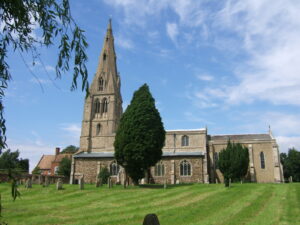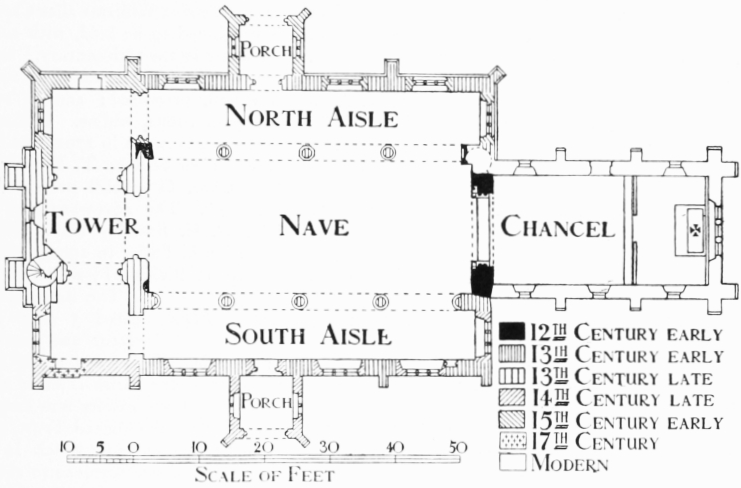Warboys
Warboys
MANOR
Warboys was the gift of Archbishop Dunstan to the Abbey of St. Benedict of Ramsey, and was confirmed by King Edgar in 974, (fn. 5) by Edward the Confessor, (fn. 6) by William the Conqueror in 1077, (fn. 7) and by Edward III in 1334; (fn. 8) and further by Pope Alexander in 1178, (fn. 9) and by Pope Gregory in 1229. (fn. 10)
Warboys was returned in the Domesday Survey among the lands of St. Benedict of Ramsey; and it was stated then that the abbot had 10 hides in the manor which paid geld. There were a priest and a church and 3 acres of meadow. There was wood for pannage 1 mile long and 1 mile broad. (fn. 11) The same hidage was given in the 13th century survey for ‘Wardebois cum Caldecote,’ (fn. 12) 30 acres being reckoned to the virgate and 4 virgates to the hide. (fn. 13) An inquisition concerning customs and rents in 1251 again returns Warboys and Caldecote as of 10 hides. (fn. 14)
There was a wood belonging to the manor extending from Middelgrave to Mareweye, from Mareweye to Wolfheye, from Wulfheye to Newedyche, and from Newedyche to Middelgrave. (fn. 15) The marsh of Warboys belonging to the manor was a subject of dispute during the abbacy of Abbot Rainulf (1231–53) with the Abbey of Thorney. The dispute resulted in Abbot Rainulf granting to Thorney half the herbage, between the weirs of Tyllingwere and Wulveywere from the river to the next ‘merefen’ in Warboys marsh, for a rent of one penny. Thereupon the Abbot of Thorney acknowledged that all the soil of the marsh was the property of the Abbot of Ramsey as belonging to his manor of Warboys. (fn. 16) The Abbot of Ramsey’s tenants at Broughton had rights of pasturage, etc., in this marsh, but had to pay to the manor of Warboys for licence to enter. (fn. 17) The tenants of Warboys with those of Broughton had rights of common in Wystow Marsh, but not beyond the “Drauht” without licence of the abbot. (fn. 18)
In 1279 the Abbot of Ramsey held the manor of Warboys cum Caldecote of the king, including a windmill, and a messuage with a garden of 2½ acres, and gallows, tumbrel, view of frankpledge and all appurtenances. (fn. 19) In 1535 the site of the manor was leased by the abbot to John Mayhue or Mayhew of Warboys, husbandman, for 40 years at a rent of £8. (fn. 20) Two days before, a close in Warboys called Caldecotts had been leased for 40 years with the site of the manor of Broughton to John Lawrence of Ramsey, bailiff of Warboys. (fn. 21)
Dissolution
After the Dissolution the manor of Warboys with grange or farm, wood, fisheries and marsh, was granted in 1540 to Richard Williams alias Cromwell, (fn. 22) and followed the descent of Ramsey (fn. 23) until 1622, when Sir Oliver Williams alias Cromwell, jointly with his wife Anne, Henry his son and Dame Anne Carr, Henry’s wife, and Henry Williams alias Cromwell his brother, sold the manor to Sir John Leman, kt., citizen and alderman of London, to Robert Leman, and William Leman, son of Sir John’s deceased brother William. (fn. 24) In the following September, Sir Oliver Williams alias Cromwell of Hinchingbrooke, kt., with Henry Williams alias Cromwell of Ramsey, esq., his son and heir, leased to Henry Williams certain land in Upwood, in consideration of the latter conveying his interest in the pasture or warren of Woolvey (Wolvey) in Warboys to Sir John Leman. (fn. 25) Robert granted his interest in the manor to Sir John and his nephew William in 1628. (fn. 26)
A field called Wolfheye was mentioned in 1251 (fn. 53) and as Wolveye in 1291, (fn. 54) later as belonging to the infirmarer of Ramsey, (fn. 55) seems to have been the origin of a property referred to as the manor of WOLVEY. In 1535 John Warboys, Abbot of Ramsey, leased it pertaining to the infirmarer’s office, to John Somerbye of Ramsey for 40 years at a rent of 53s. 4d. (fn. 56) In 1540 the manor or farm of Wolvye was leased with the site of Warboys manor to Gabriel Throckmorton ‘in like manner as William Pope lately held it.’ (fn. 57) The separate conveyance of Wolvey pasture or warren was made to Sir John Leman, since which date it has followed the descent of the principal manor.
 Church
Church
The Church of ST. MARY MAGDALENE, formerly of the BLESSED MARY THE VIRGIN, (fn. 58) consists of a chancel (34 ft. by 17 ft.), nave (49 ft. by 20 ft.), north aisle (8½ ft. wide), south aisle (8 ft. wide), west tower (12 ft. by 11½ ft.), north and south porches. The walls are of rubble and the roofs covered with lead. Nothing remains of the church which existed here at the time of the Domesday Survey (1086). The earliest church of which there is now evidence was built in the middle of the 12th century, probably when the church and its possessions were granted by Abbot Walter to the almonry of Ramsey Abbey about 1155. (fn. 59) This church consisted of a chancel and the present nave and a north aisle. (fn. 60) The chancel arch, the responds at each end of the north arcade and a small piece of walling at the south-west corner of the nave of this church still survive. Early in the 13th century, the Norman north aisle with the arcade was rebuilt, and immediately afterwards the south aisle with its arcade was added. (fn. 61) In the middle of the 13th century the west tower with its broach spire of ashlar was built, and it was evidently intended at this date to extend the aisles westward to the line of the west wall of the Tower.
Advowson
A church and a priest at Warboys were recorded in 1086, and the church was confirmed to Ramsey Abbey with the manor by Popes Alexander and Gregory. Alfred, the priest of Warboys, witnessed numerous deeds between 1114 and 1130. (fn. 63)Between 11


